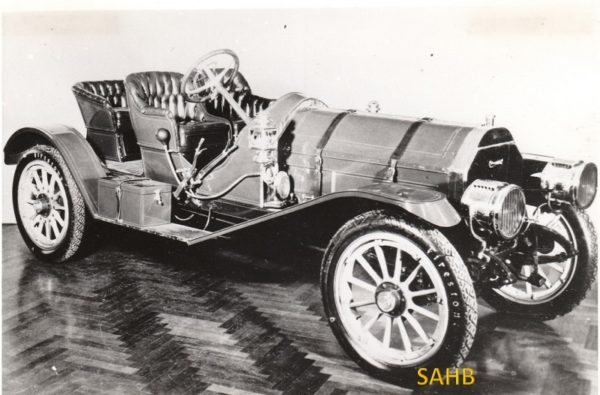
A single glance at this week’s ‘Snapshot’ is sufficient for the early car enthusiast to say, “American raceabout of the mid-Edwardian period.” Mercer and Stutz are perhaps the most familiar makes to offer ultra-sporting catalogue models of this genre. A pair of skimpy bucket seats at chassis level, a bolster fuel tank aft, and the bodywork otherwise limited to a bonnet and lightweight ‘gull-wing’ front and rear mudguards. And a ‘monocle’ circular windscreen supported by a bracket from the much-raked steering column was an extra that offered admittedly minimalist weather protection.
The ‘raceabout’ style wasn’t limited to expensive high-performance chassis such as the Mercer and the Stutz; quite a number of makes across the price spectrum listed similar styles, from Chalmers-Detroit, Hudson and Moon, to Oldsmobile and even Overland, although the styling of most of these ‘raceabouts’ was not quite so extreme. ‘Roadster’-style coachwork featured a higher seating position, token scuttle panelling and usually a windscreen, and for the truly faint-hearted, a folding canvas hood.
Our photograph shows a 1910 Great Chadwick Six ‘tourabout’, a hugely expensive car built in small numbers with competition never far from the mind of its talented progenitor, Lee Sherman Chadwick. After expanding from component manufacture in Philadelphia, Chadwick launched his first chassis, a large 4-cylinder conventional car for the 1905 season. Encouraged by a modest level of sales, in 1907 he revealed his pièce de résistance, the Great Chadwick Six – modesty was not one of Chadwick’s more notable characteristics. Indeed, his advertisements ran: ‘The Fastest, Most Powerful and Most Luxurious Automobile in the World’. Chadwick’s ambitious programme called for larger premises shortly after the Great Six was announced and these he found in Pottstown, some 35 miles north-west of Philadelphia.
The Great Six had a 60hp engine, the cylinders cast in pairs, with each pair enclosed in a brass water jacket, and the bore and stroke were 5 x 6ins – giving a swept volume just over 11½ litres. Hidden in our photograph is a Chadwick feature – side chain drive, with the chains and sprockets enclosed in finely-engineered aluminium castings. The Chadwicks were indeed fast, with in excess of 80mph readily attainable, and racing successes soon followed, some when an early form of supercharging was fitted. This was offered too as an extra on production chassis. Chadwick fell out with his business partners over his intention to introduce a ‘Perfected Great Chadwick Six’, maybe an egoistical step too far, and in 1911 he left the firm that bore his name. Decline followed and the doors finally closed in Pottstown in 1915, total Chadwick production being no more than around 250 chassis.
It was near his home in Pottstown that William S Pollock discovered the Chadwick we illustrate, still in good order, back in the 1950s. At that time, Pollock was President of the Antique Automobile Club of America, and a leading collector of top early cars. Then another example of the same model, this time in ruinous condition came to light and this he also bought and restored with a large touring body and full weather equipment. Both cars were on display in his museum in the town for many years. It is rather satisfying to report that the pair, both finished in bright red with acres of highly-polished brass-work, have stayed together, moving from one leading US collection to another through the ensuing years. Some Chadwick parts, too, survived and these have permitted a third example to be built up. A sporting open tour-seater finished in white, it is a most impressive vehicle.







Leave a Comment